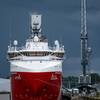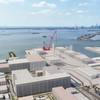Offshore Wind: The Domino Effect
Matt Tremblay, SVP, Global Offshore, ABS, discusses the next hot growth market ... offshore wind. While the market grows, the question begs: Is the U.S. marine industry ready to meet demand?
The American Bureau of Shipping convened a conference to discuss the pace and direction of the U.S. offshore wind market, including challenges and opportunities for maritime, offshore, subsea and logistics markets. Matt Tremblay, SVP, Global Offshore, ABS, moderated the event and shares some of its findings here.
Where do you see opportunities today for growth in the U.S. offshore wind sector?
There’s a lot of opportunities and growth that we’re going to experience over the next five to 10 years. The question isn’t so much ‘how much growth,’ rather how fast is that growth going to happen and how much capacity is there available on the design side, the construction side and the operation side of this business within the U.S. to support that growth?
What do you see today as the main challenges to get this market up to speed and scale?
The biggest challenge around the industry is the investment decisions around the vessels that are going to be supporting the installation and operations of offshore wind assets in the United States. These are installation vessels and SOVs that require an investment of $100m to $300m, an investment that is very hard to make on spec. You don’t want to take a lot of risk in an emerging market with investment numbers that high. Having a contract that’s going to support that investment to get that that investment from the banks, the financial support a project like this needs, is difficult when we’re still in the infancy stages. Getting those first few contracts going, I think, is going to be one of the biggest hurdle for us to overcome to start seeing the exponential growth in the market.
With many OSVs sitting idle, do you see a possibility for conversions, or is this mostly a newbuild market?
Looking at the needs of the wind farm installation and support vessels, like the vessels built and designed in Europe, while we would like to see new opportunities for greater utilization of OSVs that have been somewhat stranded for the last few years, it is likely that most of these (offshore wind) vessels are going to have to be specifically designed, new built vessels to support the unique technical aspects and functions.
How does the new tech sweeping through the industry today play into the growth in the offshore wind sector?
Now this is a place where we are able to take advantage of the things that we’re learning and in the offshore sector, specifically the OSV market, and apply a lot of that existing or newly emerging technology to the vessels that are going to be operating in offshore wind. One example is hybrid power systems, as we have seen a lot of success in the OSV market over the last few years with the installation of battery and hybrid power systems to increase the efficiency of vessels operating in the Gulf of Mexico and around the world. Also, the application of new digital technologies create opportunities to use tools like digital twin for asset integrity management, as well to support other operating characteristics as far as vessel optimization. I think the possibilities that we see starting to come out of the offshore industry on the MODUs, on the FPSOs, even on the OSVs; there are a lot of those similar types of technologies that we could apply to these same vessels to take a marginally smaller CAPEX and result in a pretty good OPEX return over the next 20 years of the vessel’s life.
What are some of the main questions you’re receiving from owners interested in this offshore wind market?
Class has become a resource of technical expertise and advisory services around OPEX optimization, around design optimization and around risk management. A lot of the questions that we’re getting in that area from the wind market are tied to many of those similar things that we work with all the maritime and offshore industry. Areas such as design optimization opportunities within the drivetrain in the power system, to hull design optimization, to the conceptual approval of new technologies as they’re utilized either because they’ve been invented or because they’re being moved from one industry into maritime. For example, we have crane technologies, we have walk to work gangways, we have different digital tools that are now being installed on board assets that they really haven’t had a lot of experience (on these new technologies) prior to the last 10 years. Class is being relied upon to identify the risks related to those new technologies, to ensure we’re meeting the mission of classification and helping to keep these assets safe, these operators safe, these workers safe, as well as protecting the environment.
As a ship owner interested in the offshore wind market, what should I be doing, today, to prepare?
First it is preparing yourself to know what’s different in operating in this this Outer Continental Shelf (OCS) environment. Second, start having conversations early with regulators, class, the Coast Guard and flag to make sure that you have a true understanding of what the regulatory challenges are, and how they may be different. You should start to work out what your own business risk profile is in this emerging market, understanding the risks in this industry versus, for example, the OSV or crew boat markets.













